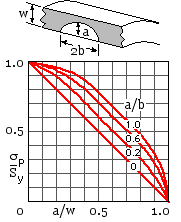Determine the fracture load of a similar sheet with a 100 mm crack. [ 354 MPa ]
| (a) | low alloy steel | yield 1.2 GPa | toughness 70 MPa√m, |
| (b) | maraging steel | yield 1.8 GPa | toughness 50 MPa√m |
Calculate the minimum defect size which will lead to brittle fracture in service for each material, and comment on the result ( this last is important ). [ 4.9, 1.1 mm ]

Determine the critical crack length if the toughness is 50 MPa√m. [ 14 mm ]

If the failure load is 10 kN, what fracture toughness is indicated ?
Is the result valid ?
Note that width and crack size are reckoned from the load's line of action. [ 80 MPa√m ]
What size and mass of SEN bend test specimen is necessary, and what capacity of testing machine would be required ?
Assume fracture at α = 0.5. [ 126 kg, 590 kN ]

| (a) | tough, weak | yield 700 MPa | plane strain toughness 100 MPa√m |
| (b) | brittle, strong | yield 1400 MPa | plane strain toughness 50 MPa√m |
Plot, as a function of crack length, the failure stress for each material due to the separate mechanisms of elastic fracture and plastic collapse.
Comment on the trends of these graphs.

Consider the equilibrated distribution of yield stress across the ligament and hence show that plastic collapse may be caused by any combination of M and N which satisfies :-
m + n ( n + 2α ) = ( 1 - α )2 where α = a/w ; n = N/bwSy ; m = 4M/bw2 Sy
What is the maximum safe load if the crack depth is 2 mm ? [ 770 kN ]
If the load is 200 kN, what crack depth is tolerable ? [ 12 mm ]
Crude manufacture leads to the expectation of 2 mm cracks extending right along the weld root.
 Multiple service failures occur when the deposition properties are as (b) below. Would a change to (a) or to (c) alleviate the problem ?
Multiple service failures occur when the deposition properties are as (b) below. Would a change to (a) or to (c) alleviate the problem ?
| deposition | (a) | (b) | (c) |
| yield ( MPa ) | 600 | 800 | 1000 |
| toughness ( MPa√m ) | 120 | 90 | 60 |

A semi-elliptical longitudinal fatigue crack ( a=10, b=20 mm) is discovered at the bore during routine inspection. What is the actual safety factor of the flawed vessel. [ 1.26 ]
If the toughness were to drop to 35 MPa√m due to a drop in ambient temperature, what then would be the safety factor ?
Assume configuration factors - plastic as graphed, and elastic 'Y' thus :
Y = C1 [ 1 + C2 ( 1 - cos πα )] where
C1 = 2.24 /( 1 + exp πβ/4) ; C2 = 2.34/( 1 + exp 4√β ) ; β = a/b
Estimate the crack depth after 100 hours operation, assuming a Paris exponent of 2.7 and a stress intensity range of 1.6 MPa√m corresponding to a growth rate of 1 mm/Mc. The configuration factor Y may be approximated by that of case ( d). [ 11 mm ]
Neglecting instability, determine the number of cycles necessary for a 5 mm crack to grow to 15 mm, if the component is subjected to a cyclically varying stress of :
(a) 0 to 40 MPa [ 2.1 Mc] ; (b) 100 to 120 MPa [ 34 Mc]